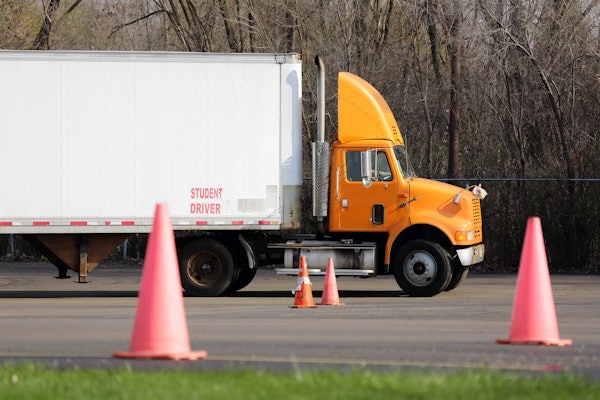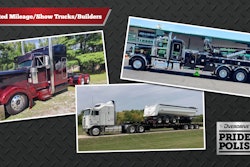Under the new securement regulations, (bottom) it is no longer legal to have tie-downs on the outside of the rub rail.
The year-old cargo securement rule that has been enforced since Jan. 1 was developed primarily as a result of severe accidents caused by unstable loads.
Other triggers for the revision were, first, the higher forces on cargo generated by trucks with better brakes, tires and suspensions; and second, the desire to synchronize the Canadian, American and Mexican rules. The goal for the updated regulations is to avoid shifting loads, which can cause the driver to lose control and the truck and trailer to flip.
Considering that the new rule makes it easier to be put out of service, it’s even more important to understand it. In addition to weight and length criteria, there are more specific regs that involve routing of straps and chains, as well as regs that vary by commodity type.
WEIGHT
One existing rule didn’t change Jan. 1: The sum of tie-downs’ ratings must equal half the weight of the cargo. Tie-downs are rated according to their “working load limit,” which is one third of their breaking strength.
To conform to the strength versus weight rule requires knowing the weight of the cargo and the rating of your tie-downs. The rating refers to not only the material they are made of, but also the weakest part of the assembly. You must determine the rating either by checking a marking the manufacturer has put on the tie-down or by referring to charts incorporated in the new regs. You can look up the rating in the charts based on what the tie-down is made of and its dimensions – for example, wire rope with a diameter of 5/16 inch is rated at 2,100 pounds. Get a calculator and add up the ratings of all the tie-downs you’ve installed. Doing the math will help you know you can pass roadside inspections.

ROUTING
For many commodities, the new regs give specifics as to how and where tie-downs may be routed. For example, when hauling steel coils with the eyes crosswise on the trailer, tie-downs must not be crossed so as to form an X when viewed from above. The regs tell the loader how many tie-downs are needed and which type of motion each must prohibit.
You can no longer nail down blocking because nails often loosen. Use a 4-inch-by-4-inch cradle instead. It must support the coil off the trailer floor in order to minimize the chance that it will roll.
Running your tie-downs over the side of the trailer now requires greater caution. Jim Calico, vice president of sales and marketing at Kinedyne Corp., cites the new rule: “All tie-downs and other components of a cargo securement system used to secure loads on a trailer equipped with rub rails must be located inboard of the rubrails, whenever practicable.” The reason is that rub rails sometimes rub other vehicles or walls, so a rope or cable on the outside of the rails can be damaged, leaving the cargo improperly secured. He believes the “whenever practicable” qualification will cause a lot of confusion.
Kinedyne makes a Kaptive Hook for fastening straps. It has only a small opening and hooks around an attaching pin running from the inside of the rub rail to the edge of the trailer floor. The strap can ride up and down quite a bit prior to tensioning, or if tension gets lost, without slipping off the pin.
Dick Hugg, president of Hugg Manufacturing and a small-fleet owner, developed two systems geared to meeting the new requirements. The first one solves the same problem as the Kaptive Hook, that of “securing the buckle end of securement straps by passing the buckle between the side rail of the trailer and the rub rail,” says company literature. Hooking this way keeps the hook from falling off if the strap gets slack in it, but it passes the strap outboard of the rub rail.
Hugg Manufacturing’s PortaAnchor “has been developed in direct response to the new securement regulations forbidding securement outside the rub rail,” the company says. “It offers an anchor point for both synthetic straps and chains and secures to the stake pockets. It provides a receptacle that the hook can pass under and then come up to hook in the same manner it would on a rub rail.” Gravity then keeps the hook hooked.
The PortaWinch “uses 4-inch straps and the same winch bar used on the standard underbody winches. This winch also attaches using the trailer’s stake pockets, which are rated securement points,” the company says. The newer version engages the stake pocket using a spring-loaded hook formed out of flat metal, guaranteeing that the hook will remain hooked.
COMMODITY
Requirements by commodity type are the real meat of the new rule, says Bill Gouse, vice president of engineering at the American Trucking Associations. These highly detailed regs take precedence over the general rules whenever there is a conflict. Special requirements apply to each of these categories:
“For a specialized commodity, get with the shipper,” says Jim Feddern of the Ohio State Highway Patrol and the chair of the Commercial Vehicle Safety Alliance vehicle committee. Shippers are often the experts as to how to stow their stuff because of their liability concerns. You can also read the rule itself at the CVSA and Federal Motor Carrier Safety Administration websites. Feddern also suggests contacting the state agency that will be enforcing the rules in your jurisdiction.
DIMENSION
The weight versus tie-down capacity aspect of the law has not changed, but the new rule gives length more attention. “Tie-downs must be adequate for both weight and length,” Feddern says. “These are now two separate issues.” The rule is, in part, two tie-downs if the article weighs more than 1,100 pounds and is 10 feet or longer; plus one additional tie-down for every 10 feet or fraction thereof beyond 10 feet.
There must still be one tie-down for every 10 feet of length even if when using blocking and bracing. This aspect of the rule applies regardless of the weight and its relationship to the load limits of the tie-downs.
TENSION
Too much tension on the tie-downs is almost as bad as not enough. It’s normally not a good idea to use a cheater bar of any kind or substitute another pry bar – the one provided by the winch or tensioner maker is designed to help you apply the right amount of torque. Larry Strawhorn, former vice president of engineering at American Trucking Associations, suggests that if you’re worried about how tight to make things, get materials from a dealer or distributor that has a relationship with the manufacturer. If you can’t get results that way, try your state trucking association or industry associations.
BRACING
“Cargo securement isn’t about tying cargo to the trailer,” Feddern says. “It’s about maximizing the friction between the cargo and the trailer. That’s why blocking and bracing are so effective, and why using rubber mats can also be a great aid to cargo safety.”
After the cargo is tied down with good gear, if possible, use blocking or bracing to block movement. “Use sturdy timbers, not just a piece of 2-by-4,” says Feddern. Ideally, any block will have a beveled edge so the cargo will have a wider surface to rest against and be less likely to crush the wood and work its way loose. If friction mats are used and are not rated as to how much force they produce versus the weight carried, they will be assumed to produce friction equivalent to one half the weight placed on the mat.
CONDITION
Under the old rule, if a fourth of a trailer’s tie-downs were found defective, you could be put out of service. Now, one defective tie-down does the trick. Consequently, you should thoroughly check the condition of your securement equipment as you load.
You also need to know what is considered defective. Equipment must have “no damaged or weakened components … and must not have any cracks or cuts,” the rule says. Ropes must have no knots. There are strict standards on the extent to which wire rope may be frayed.
“New stuff costs a lot less than getting a ticket,” Gouse says. Replace anything that’s not in perfect condition except where allowances make it legal.
To maintain equipment – and to comply with the rule – pay close attention to sharp edges. “When a strap runs over something so that it could be damaged by a sharp edge, it needs an edge protector,” says Feddern.
CHECKING
The new rule says you have to stop after 50 miles and recheck and retension everything. This process must be repeated again every three hours or 150 miles, whichever comes first, and every time you change your duty status.
These periodic checks, as well as careful inspection of equipment with every new load, can be inconvenient and might seem unnecessary. However, the attentiveness will pay off in better safety and fewer out of service orders.
GOTCHA!
Enforcement of securement regulations is expected to be tough because more than a year has passed since they were introduced. The following are the violations officials expect to be most common:
RESOURCES
Commercial Vehicle Safety Alliance
(202) 775-1623
www.cvsa.org
Federal Motor Carrier Safety
Administration
www.fmcsa.dot.gov
Specialized Carriers and Rigging
Association
(703) 698-0291
www.scranet.org
Web Sling Tiedown Association
(410) 931-8100
National Association of Chain
Manufacturers
(703) 299-8414
Hugg Manufacturing Inc.
(888) 903-5958
www.huggmanufacturing.com
Kinedyne Corp.
(800) 848-6057
www.kinedyne.com













